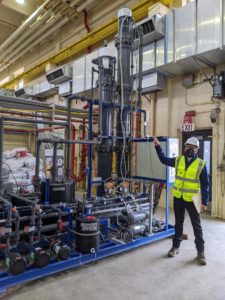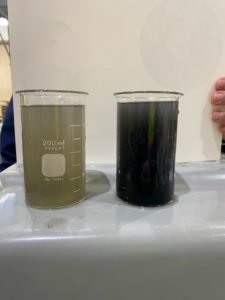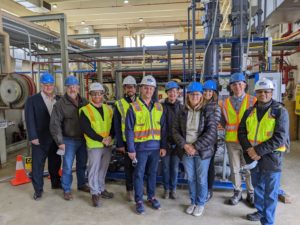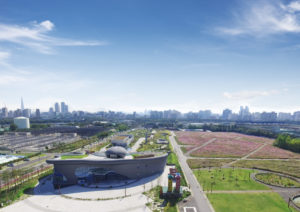Tomorrow’s Technology Treating Water Today
By Karen Frost, Vice President for Economic Development & Innovation
 You won’t find a group of people more excited to visit a wastewater treatment plant than The Water Council staff. Especially when we’re checking out a potentially groundbreaking technology.
You won’t find a group of people more excited to visit a wastewater treatment plant than The Water Council staff. Especially when we’re checking out a potentially groundbreaking technology.
Several of us took a trip to the South Shore Water Reclamation Facility in Oak Creek, Wis., to check out a pilot demonstration by Tomorrow Water of its Proteus technology. The four-month pilot is part of The Water Council’s Pilot Program, arranged in partnership with the Milwaukee Metropolitan Sewerage District (MMSD).
Traditionally, wastewater is first treated in settling tanks. Solid waste settles at the bottom of the tanks, and the remaining liquid is moved to the next stage. But this process requires time and space, as the water must sit for one to two hours for the solids to settle.

Using the Proteus technology, water is actively treated in the primary stage by flowing up through the filtration media. The filters catch solids, allowing the water to continue to flow through the system. This allows what used to take up to two hours to happen in six to eight minutes, said Jon Liberzon, vice president of Tomorrow Water. Because water is actively flowing through the system instead of sitting idle, the amount of space needed is reduced by up to 80%. The system can also be installed underground, saving even more space.
“The beauty of it is it’s a very simple design,” said Matt Magruder, MMSD environmental research manager.
The system could also catch more solids than traditional primary clarifying. So far, the pilot demonstration has removed more than 80% of solids, compared with 50-70% that you can expect from a conventional primary clarifier. It also has the potential to divert carbon, increase biogas production to power the facility and reduce greenhouse gas emissions in the process.

Tomorrow Water also offers Proteus Plus, which adds biology to the process to help remove not only suspended particles, but also colloidal and dissolved pollutants.
The reduced time and space required could be especially beneficial in places like Milwaukee that operate combined sewer systems, where wastewater and stormwater flow through the same system. MMSD’s South Shore and Jones Island plants typically treat about 150 million gallons of wastewater on a dry day, but that can grow to 690 million gallons during a major rainstorm. If the pilot is successful and the technology is adopted, it could help the plants handle more water moving more quickly through the system, further reducing the possibility for overflows.
The pilot is a prime example of The Water Council’s work promoting water technology solutions and more evidence that Wisconsin is a place Where Water Works. Although this technology is already in use at more than 60 facilities in South Korea, home of Tomorrow Water’s parent company BKT, it is still getting established in the U.S. This pilot will help municipalities across the country understand the potential for the technology and potentially adopt a solution that’s more sustainable and saves time and space. We call that a win-win-win.

